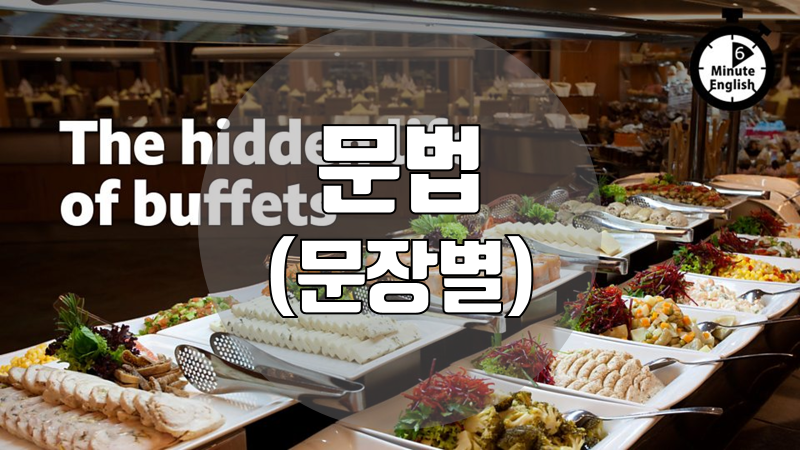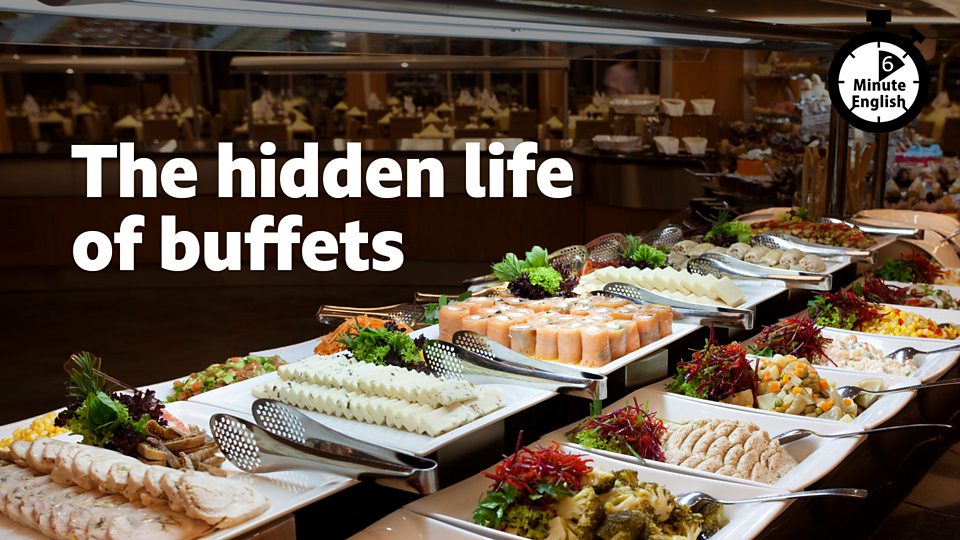
이번주 BBC Learning English - 6 Minute English가 다룬 문법 관련 이슈 는 관계대명사(5), that(4), 동명사(3), 법조동사(3), 비교 구문(2), 관계부사(2), 시제(2), 접속사(2), as(2) 등이였습니다. 그 외에 it, 전치사, 전치사 구문, 대명사, 동사 구문과 용법, 문장성분, 삽입 구문, 분사 등이 각각 1 건씩 다루어졌습니다.
[본문] [05] Have you ever been to an all-you-can-eat buffet, Sam?
[설명] 『Have you ever been ~』은 현재완료 시제 구문입니다. 현재까지의 '경험'을 나타냅니다. '~라고 ~한 적이 있다'
[본문] [06] You know - a meal in a restaurant where you can eat as much food as you like.
[설명] 「as much food as」는 「as 형용사 as」 구문으로 동등 비교(원급 비교) 구문입니다.
[참조 링크]☞ as 형용사 as 비교구문 / 두 as의 차이점
[본문] [09] It sounds like your eyes were bigger than your belly, or stomach - a phrase describing someone who has taken more food than they can eat.
[설명] ⑴ 『It sounds like ~』의 like는 접속사입니다.' ~인 것처럼 들리다'
⑵ 『describing ~』은 현재분사 구문으로 'a phrase'를 후위수식합니다. 분사 앞에 「주격관계대명사와 be 동사」가 생략되어 있다고 생각할 수 있습니다.
⑶ 『who has taken ~』의 'has taken'은 현재완료 시제 구문입니다. 현재까지의 '경험'을 나타냅니다. '~라고 ~한 적이 있다'
[본문] [10] In this programme we'll be discussing buffets - a feast of many different food dishes where diners are allowed to eat as much as they want - or as much as their stomachs will allow.
[설명] ⑴ 『where diners are allowed』의 where는 관계부사입니다, 선행사는 'a feast'입니다.
⑵ 『as much as they want』의 「as much as」 구문은 수량을 비교하는 구문으로, 불가산명사에 사용합니다.
[본문] [12] The popularity of buffets is booming, especially in Middle Eastern and Asian countries where the variety of foods means there's something for everyone.
The popularity of buffets is booming, especially in Middle Eastern and Asian countries where the variety of foods means {that} there's something for everyone.
[설명] ⑴ 『where the variety of foods means』의 where는 관계부사입니다, 선행사는 'Middle Eastern and Asian countries'입니다.
⑵ means 뒤에 명사절을 이끄는 접속사 that이 생략되었습니다. 절의 문장성분은 목적어입니다.
[본문] [13] But feasts are big and boastful - usually too much is cooked, and buffets have been criticised for waste.
[설명] 『usually too much is ~』의 주어는 부사(구)인 「too much」입니다. 이와 같이 부사어구가 문장의 주어가 되는 것을 부사적 주어라고 합니다.
[본문] [15] The word 'buffet' originated from the French name for the table on which food was served, but buffets themselves don't come from France.
[설명] 『buffets themselves』의 themselves는 재귀대명사입니다. 주어인 buffets를 강조하는 강조용업입니다. 이 때 재귀대명사는 「그 자신이 직접」이란 뜻입니다.
[본문] [21] John Wood, owner of cooking company Kitchen Cut, knows a lot about buffets - he used to run a one thousand seat breakfast buffet at the five-star Jumeirah Beach Hotel in Dubai.
[설명] 서법조동사 「used to」는 비교적 장기간에 걸친 과거의 상습적인 동작을 표현합니다.
[본문] [22] Here John shares his observations on human buffet behaviour with BBC World Service programme, The Food Chain.
[설명] 『shares his observations ~』는 「share A with B」 구문으로 'A를 B와 공유하다'의 의미를 갖습니다.
[본문] [23] There are different people that treat buffets in different ways.
[설명] 『that treat buffets ~』의 that은 관계대명사 입니다. 격은 주격이고, 선행사는 'different people'입니다.
[본문] [24] Some people think this is a great opportunity to try little bits and lots of everything, and we come back as many times as I like.
Some people think {that} this is a great opportunity to try little bits and lots of everything, and we come back as many times as I like.
[설명] ⑴ people 뒤에 명사절을 이끄는 접속사 that이 생략되었습니다. 절의 문장성분은 목적어입니다.
⑵ 『as many times as I like』의 「as many ~ as」 구문은 수량을 비교하는 구문으로, 가산명사에 사용합니다.
[본문] [25] And other people just - whether they don't like getting up and down, which is understandable from their table - just want to pile it high, and people they want to get value for money.
[설명]
☞ 문장 구조 분석 코너 참조 바랍니다.
[본문] [26] So, if you're paying $100, $200 a head for a buffet, you're gonna pile it up high and take the most expensive things you can you know, and get your money's worth.
So, if you're paying $100, $200 a head for a buffet, you're gonna pile it up high and take the most expensive things {which/that} you can you know, and get your money's worth.
[설명] ⑴ 선행사 'the most expensive things' 뒤에 목적격 관계대명사 which 또는 that이 생략되어 있습니다.
⑵ 「you know」는 삽입절 입니다.
[본문] [27] John says buffet diners want to get their money's worth - get good value for the money they spend, so they often pile up food on their plate.
John says {that} buffet diners want to get their money's worth - get good value for the money {which/that} they spend, so they often pile up food on their plate.
[설명] ⑴ 'John says' 뒤에 명사절을 이끄는 접속사 that이 생략되었습니다. 절의 문장성분은 목적어입니다.
⑵ 선행사 'the money' 뒤에 목적격 관계대명사 which 또는 that이 생략되어 있습니다.
[본문] [28] If you pile something up, you gather a large amount of it into one place to build what's called a pile.
[설명] 『what's called ~』는 what 주격 관계대명사절입니다. 절의 문장 성분은 목적어 입니다.
[본문] [29] But buffets are not just about eating until you explode - they're also an opportunity to show off to your friends.
[설명] 『until you explode』눈 "~꺄지". 기간을 나타내는 종속 접속사 until이 이끄는 부사절입니다.
[본문] [31] The richer the people getting married, the bigger the buffet, sometimes inviting as many as five thousand guests.
[설명] 『The richer ~, the bigger ~』는 「the 비교급 the 비교급」 구문으로 「~하면 할수록 더욱 … 하다」의 의미를 갖습니다. .
[참조 링크]☞ 기초영어문법 68 'the 비교급 S V, the 비교급 S V' 구문 완전정복
[본문] [33] Sandeep Sreedharan is a wedding caterer from Goa in South India - he owns a company which provides the food and drink for special social occasions.
[설명] 『which provides the food ~』의 which는 주격의 관계대명사입니다. 선행사 'a company'를 수식하는 제한적 용법입니다.
[본문] [34] Here he talks with Ruth Alexander, presenter of BBC World Service, The Food Programme, about organising an Indian wedding buffet:
[설명] organising 동사적 목적어는 『organising ~』은 동명사(구)입니다. 전치사 about의 목적어입니다. 또한 동사적인 성질을 갖고 있어 「an Indian wedding buffet」를 목적어로 취하고 있습니다.
[본문] [36] Everybody wants to overwhelm everybody around you.
[설명] 『wants to overwhelm』은 「동사+부정사」 구문으로 부정사가 want의 목적어가 되는 3형식 구문입니다.
[본문] [39] They are out to impress - they want to 'wow' the guests - knock their socks off.
[설명] ★ knock your socks off 누군가를 놀라게 하고 감동시키다
[본문] [41] They should just go back saying, 'I couldn't eat even half of it!', you know.
[설명] 『should just go back ~』의 법조동사 should는 약한 추론을 나타냅니다.
[본문] [43] They don't even worry about who's wedding is it… They know that… 'Who's the caterer?
[설명] who's → whose
[본문] [46] Wedding buffets are designed to amaze and overwhelm the guests with their huge displays of food.
[설명] 『their huge displays of food』의 of는 '목적격의 of'입니다. A of B의 관계에서 'B를 A.하는 것'이라는 '목적어+술어'의 의미 맥락을 갖습니다, 즉, '그들이 음식을 거대하게 전시하다'라는 뜻을 갖습니다.
[본문] [49] It seems the secret to enjoying a buffet is trying a little bit of everything, without stuffing yourself until you can't move - although in the past, I think, that was exactly the idea.
It seems {that} the secret to enjoying a buffet is trying a little bit of everything, without stuffing yourself until you can't move - although in the past, I think, that was exactly the idea.
[설명] ⑴ 「it seems that ~」 구문입니다. it가 가주어, that절이 진주어입니다. that절의 주어인 ~'이 ...인 것 같다'라는 뜻입니다. 진주어를 이끄는 접속사 that이 생략되어 있습니다.
⑵ 『trying』은 현재진행형이 아니라 명사적 용법의 동명사입니다. 문장성분은 주격 보어입니다. '먹어보는 것'이란 뜻을 갖습니다.
[본문] [50] OK, it's time to reveal the answer to my question - where did the buffets originally come from?
[설명] 『it's time to reveal』은 「it to 가주어」 구문입니다. 진주어는 「to reveal ~」 부정사(구)입니다.
pdf 파일은 이곳을 클릭하세요.
https://softca.tistory.com/2059을 클릭하세요.
이 블로그에는 [BBC 6분 영어와 관련하여 매주 다음과 같은 글들이 게시 됩니다
- 단어공부(금주 대본에 나온 주요 어휘) https://softca.tistory.com/2060
- 멀티단어공부(금주 대본에 사용된 멀티단어(구동사, 숙어) 간단 정리) https://softca.tistory.com/2061
- 독해공부(금주 대본의 문장별 해석(직역) 자료) https://softca.tistory.com/2062
- 문장별 문법공부(문장별 문법 설명) 이 글입니다
- 금주의 어휘(금주 대본에 나온 금주의 어휘를 집중적으로 정리한 자료) 이 글의 포스팅 시점에는 아직 작성되지 않았습니다.
- 항목별 문법공부(금주 대본에 나온 문법을 주제별/항목별로 정리한 자료) 이 글의 포스팅 시점에는 아직 작성되지 않았습니다.
- 금주의 구동사(금주 대본에 사용된 구동사 상세 정리) 이 글의 포스팅 시점에는 아직 작성되지 않았습니다.
- 금주의 PDF(금주의 PDF 및 기타 다운로드 파일) https://softca.tistory.com/2059
아래의 이미지를 클릭하시면 PDF로 된 대본(Script)를 다운받을 수 있습니다.
[영어 문장 공부] 자료를 처음 보시는 분은 아래의 링크를 클릭하셔서 「공부법」을 먼저 보시기를 권장 드립니다.
[영어문장공부] 학습법 보기






